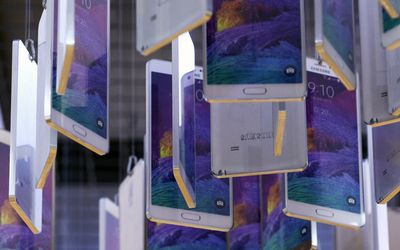SAMSUNG is that slightly awkward boy who’s been studying very hard in school. The Galaxy S7, which arrives in stores this week, is his first solid A.
Yep, Samsung just moved to the head of the smartphone class.
Would you be disappointed by buying a different phone? Probably not. There are lots of phones that score nearly as high, many for hundreds less than the $680 the Galaxy S7 can cost without a contract. Some might be sexier or eke out a little more battery life.
But after years of producing B+ phones, Samsung’s now the one I’d want to captain my mathlete squad.
The Galaxy S7 and larger S7 Edge have a camera that beat the iPhone 6s Plus in every low-light situation I’ve tested.
Its screen is a stunner, packing in more than three times as many pixels as the iPhone 6s.
And its blazing fast processor is well suited for the new world of virtual reality.
Samsung earns extra credit for calling out some of the baloney that makes smartphones annoying and costly.
Instead of gouging you for built-in storage, the Galaxy S7 lets you add your own.
And if it takes a swan dive into the toilet, it’ll live to tell the tale thanks to the addition of water resistance.
My concern: Samsung may have aced this year’s test — but only by memorising last year’s study guide. That underwater trick? Samsung is just bringing back a feature from the Galaxy S5.
There’s no versatile USB Type-C port or pressure-sensitive screen like Apple’s 3D Touch. There’s nothing surprising like the two cameras LG put on the back of its new G5.
You can’t even expect fresh Android updates: Samsung takes months to deliver the capabilities that Google introduces each year.
You will get a free (and impressive) Gear VR headset when you buy a Galaxy S7, but the phone itself doesn’t point toward the future.
The Galaxy S7 is everything you want in a smartphone — but nothing you didn’t know you wanted. I felt that way from the moment I first held the Galaxy S7.
We all want to see and do more on our phones, but our hands aren’t getting any more accommodating.
The Galaxy S7 has rounded edges that make its 5.1-inch screen feel slightly smaller than last year’s S6, and is almost as slender as the iPhone 6s with a 4.7-inch screen. For $100 more, the Galaxy S7 Edge has a 5.5-inch screen with curved glass that slopes down on both sides. Call it phablet lite: The Edge is slimmer and lighter than a 5.5-inch iPhone 6s Plus.
The curved part of the screen also comes with its own controls, which you can use to access apps, people or news with one swipe.
It’s clear Samsung was brutal in its self-assessment of past Galaxy design failings. Many of us turned up our noses at the Galaxy S4 and S5’s plasticky finish and clumsy design.
This year’s model carries over the Apple-esque glass and metal makeover from the Galaxy S6, and smooths down edges even further.
The camera bulge that marred the backside of the Galaxy S6 has been tailored down to just a hair.
Samsung’s design reckoning includes reviving a few actually useful features it had killed off too soon.
I tripled my Galaxy S7’s 32GB built-in storage by adding an $18 64 GB MicroSD card in the SIM tray.
Shame on Apple (and, previously, Samsung) for charging $100 to up storage to 64GB.
And I’m also glad Samsung brought back water resistance — up to 5 feet of water for 30 minutes — without requiring a special USB plug.
The Galaxy S7’s camera is what wowed me most. The reason we take blurry shots of city lights and people in dim restaurants is that phones’ tiny sensors have a hard time seeing in the dark.
The Galaxy S7’s new 12-megapixel camera is lower resolution than the Galaxy S6’s camera but that’s a worthy trade-off because each pixel can now capture 95% more light.
I could really see it when I hiked at sunset to my favourite hilltop overlooking San Francisco, armed with the Galaxy S7 and a stack of other smartphones. The S7 was able to focus and snap immediately, while the iPhone 6s Plus — with Apple’s best camera — kept struggling to find its spot.
Across dozens of shootouts, the Galaxy S7 photos and video had a much more pleasing dynamic range, pulling out detail in places the iPhone just left dark, without blowing out the highlights.
No question, I’d rather carry around the Galaxy S7 camera than any other.
We choose sides in the Android vs Apple divide based on how well all our stuff plays together — and how difficult it would be to switch. But cluttered, confusing software is no longer Samsung’s Achilles heel.
The Galaxy S7’s version of the powerful Android 6.0 Marshmallow is the cleanest Android version I’ve seen Samsung offer.
There’s now just one Web browser (Chrome), and Samsung also kept many aspects of Google’s elegant design.
Here’s something I never thought I’d say: I really like some of Samsung’s newest apps. Samsung+ offers support and a self-diagnostic tool for problems with your phone. And Samsung Pay lets you use your phone as a credit card at registers Apple Pay can’t, including old-timey card swipe machines. (It’s still up to you to convince many store clerks that yes, this really will work.)
The Galaxy S7’s most mediocre quality is its battery. In my lab stress test, which cycles through a series of websites at uniform screen brightness, the Galaxy S7 lasted over seven hours, about 40 minutes short of the iPhone 6s. At 8½ hours, the Galaxy S7 Edge only slightly underperformed the iPhone 6s Plus.
There’s some science behind this.
The Galaxy S7’s new battery has 75% more capacity than the one in the iPhone 6s — it’s even bigger than the one in last year’s Galaxy S6. But it has to drive a much higher-resolution screen. The Galaxy S7 compensates with power-saving smarts.
Its new always-on screen — which shows the time and basic alerts — seems like it would be a major drain. But the phone’s Amoled screen only has to power the pixels you can see. Samsung says this is more efficient than firing up the whole screen just to check the time every 20 minutes.
In regular use, the Galaxy S7 makes it through the day, but just barely. And although the battery can’t be removed like earlier Samsung phones, it is incredibly quick to charge. With Samsung’s included plug, you’ll go from 0 to 100 in under 90 minutes, about an hour faster than an iPhone 6s. (It can also charge wirelessly, but that requires extra equipment.)
The Galaxy S7 refined features that matter to become the best smartphone you can buy. That’s a giant feat. But a question haunts Samsung: In a world with lots of great smartphones, what justifies the price premium?
Samsung’s novel ideas for phones have had many goofy turns over the years — remember head-based hands-free scrolling? But don’t forget, Samsung’s early adoption of the phablet also defined the super size of every phone sold today, despite Apple’s resistance.
Samsung got out in front of the virtual reality race with the Gear VR. The Galaxy S7 should have given us a bigger dose of the future, too.
• Fowler is a personal technology columnist
More Africa news from The Wall Street Journal
More news from The Wall Street Journal
Premium access to WSJ.com: $1 a week for 12 weeks

Picture: BLOOMBERG
SAMSUNG is that slightly awkward boy who’s been studying very hard in school. The Galaxy S7, which arrives in stores this week, is his first solid A.
Yep, Samsung just moved to the head of the smartphone class.
Would you be disappointed by buying a different phone? Probably not. There are lots of phones that score nearly as high, many for hundreds less than the $680 the Galaxy S7 can cost without a contract. Some might be sexier or eke out a little more battery life.
But after years of producing B+ phones, Samsung’s now the one I’d want to captain my mathlete squad.
The Galaxy S7 and larger S7 Edge have a camera that beat the iPhone 6s Plus in every low-light situation I’ve tested.
Its screen is a stunner, packing in more than three times as many pixels as the iPhone 6s.
And its blazing fast processor is well suited for the new world of virtual reality.
Samsung earns extra credit for calling out some of the baloney that makes smartphones annoying and costly.
Instead of gouging you for built-in storage, the Galaxy S7 lets you add your own.
And if it takes a swan dive into the toilet, it’ll live to tell the tale thanks to the addition of water resistance.
My concern: Samsung may have aced this year’s test — but only by memorising last year’s study guide. That underwater trick? Samsung is just bringing back a feature from the Galaxy S5.
There’s no versatile USB Type-C port or pressure-sensitive screen like Apple’s 3D Touch. There’s nothing surprising like the two cameras LG put on the back of its new G5.
You can’t even expect fresh Android updates: Samsung takes months to deliver the capabilities that Google introduces each year.
You will get a free (and impressive) Gear VR headset when you buy a Galaxy S7, but the phone itself doesn’t point toward the future.
The Galaxy S7 is everything you want in a smartphone — but nothing you didn’t know you wanted. I felt that way from the moment I first held the Galaxy S7.
We all want to see and do more on our phones, but our hands aren’t getting any more accommodating.
The Galaxy S7 has rounded edges that make its 5.1-inch screen feel slightly smaller than last year’s S6, and is almost as slender as the iPhone 6s with a 4.7-inch screen. For $100 more, the Galaxy S7 Edge has a 5.5-inch screen with curved glass that slopes down on both sides. Call it phablet lite: The Edge is slimmer and lighter than a 5.5-inch iPhone 6s Plus.
The curved part of the screen also comes with its own controls, which you can use to access apps, people or news with one swipe.
It’s clear Samsung was brutal in its self-assessment of past Galaxy design failings. Many of us turned up our noses at the Galaxy S4 and S5’s plasticky finish and clumsy design.
This year’s model carries over the Apple-esque glass and metal makeover from the Galaxy S6, and smooths down edges even further.
The camera bulge that marred the backside of the Galaxy S6 has been tailored down to just a hair.
Samsung’s design reckoning includes reviving a few actually useful features it had killed off too soon.
I tripled my Galaxy S7’s 32GB built-in storage by adding an $18 64 GB MicroSD card in the SIM tray.
Shame on Apple (and, previously, Samsung) for charging $100 to up storage to 64GB.
And I’m also glad Samsung brought back water resistance — up to 5 feet of water for 30 minutes — without requiring a special USB plug.
The Galaxy S7’s camera is what wowed me most. The reason we take blurry shots of city lights and people in dim restaurants is that phones’ tiny sensors have a hard time seeing in the dark.
The Galaxy S7’s new 12-megapixel camera is lower resolution than the Galaxy S6’s camera but that’s a worthy trade-off because each pixel can now capture 95% more light.
I could really see it when I hiked at sunset to my favourite hilltop overlooking San Francisco, armed with the Galaxy S7 and a stack of other smartphones. The S7 was able to focus and snap immediately, while the iPhone 6s Plus — with Apple’s best camera — kept struggling to find its spot.
Across dozens of shootouts, the Galaxy S7 photos and video had a much more pleasing dynamic range, pulling out detail in places the iPhone just left dark, without blowing out the highlights.
No question, I’d rather carry around the Galaxy S7 camera than any other.
We choose sides in the Android vs Apple divide based on how well all our stuff plays together — and how difficult it would be to switch. But cluttered, confusing software is no longer Samsung’s Achilles heel.
The Galaxy S7’s version of the powerful Android 6.0 Marshmallow is the cleanest Android version I’ve seen Samsung offer.
There’s now just one Web browser (Chrome), and Samsung also kept many aspects of Google’s elegant design.
Here’s something I never thought I’d say: I really like some of Samsung’s newest apps. Samsung+ offers support and a self-diagnostic tool for problems with your phone. And Samsung Pay lets you use your phone as a credit card at registers Apple Pay can’t, including old-timey card swipe machines. (It’s still up to you to convince many store clerks that yes, this really will work.)
The Galaxy S7’s most mediocre quality is its battery. In my lab stress test, which cycles through a series of websites at uniform screen brightness, the Galaxy S7 lasted over seven hours, about 40 minutes short of the iPhone 6s. At 8½ hours, the Galaxy S7 Edge only slightly underperformed the iPhone 6s Plus.
There’s some science behind this.
The Galaxy S7’s new battery has 75% more capacity than the one in the iPhone 6s — it’s even bigger than the one in last year’s Galaxy S6. But it has to drive a much higher-resolution screen. The Galaxy S7 compensates with power-saving smarts.
Its new always-on screen — which shows the time and basic alerts — seems like it would be a major drain. But the phone’s Amoled screen only has to power the pixels you can see. Samsung says this is more efficient than firing up the whole screen just to check the time every 20 minutes.
In regular use, the Galaxy S7 makes it through the day, but just barely. And although the battery can’t be removed like earlier Samsung phones, it is incredibly quick to charge. With Samsung’s included plug, you’ll go from 0 to 100 in under 90 minutes, about an hour faster than an iPhone 6s. (It can also charge wirelessly, but that requires extra equipment.)
The Galaxy S7 refined features that matter to become the best smartphone you can buy. That’s a giant feat. But a question haunts Samsung: In a world with lots of great smartphones, what justifies the price premium?
Samsung’s novel ideas for phones have had many goofy turns over the years — remember head-based hands-free scrolling? But don’t forget, Samsung’s early adoption of the phablet also defined the super size of every phone sold today, despite Apple’s resistance.
Samsung got out in front of the virtual reality race with the Gear VR. The Galaxy S7 should have given us a bigger dose of the future, too.
• Fowler is a personal technology columnist
More Africa news from The Wall Street Journal
More news from The Wall Street Journal
Premium access to WSJ.com: $1 a week for 12 weeks




















Change: 0.40%
Change: 0.47%
Change: -0.49%
Change: 0.53%
Change: 1.03%
Data supplied by Profile Data
Change: 1.71%
Change: 1.28%
Change: 0.40%
Change: 0.00%
Change: 1.64%
Data supplied by Profile Data
Change: -1.27%
Change: 0.00%
Change: 0.05%
Change: -0.08%
Change: 0.35%
Data supplied by Profile Data
Change: -0.02%
Change: 0.21%
Change: -0.06%
Change: 0.53%
Change: 0.70%
Data supplied by Profile Data